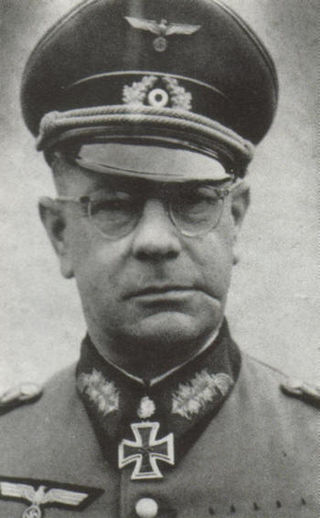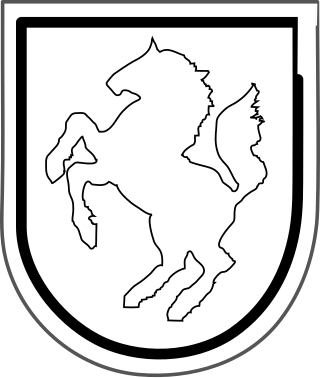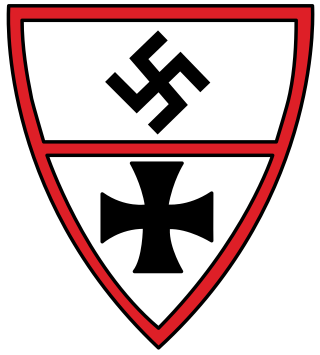Operations
The XXXXIII. Army Corps was created on 15 April 1940 in military district XI (Weimar).
It participated in the Battle of France, where it played only a secondary role. After the French capitulation it occupied the Channel coast in the area of Rouen.
In June 1941, it participated in Operation Barbarossa as part of the 4th Army. It fought in the Battle of Białystok–Minsk and Battle of Kiev (1941). In November 1941, it reached the city of Aleksin on the Oka River but was pushed back towards Spas-Demensk by the Soviet counter offensive in the Battle of Moscow.
It stayed in Spa-Demansk during 1942 and was moved to Velikiye Luki in 1943, where it was involved in the Battle of Nevel (1943). In March 1944, it became part of Armee-Abteilung Narwa and fought in the Battle of Narva (1944). In Autumn 1944, the Corps was locked up in the Courland Pocket.
In March 1945 the General Command was evacuated over sea from the Courland Pocket and added to the 8th army in Northern Hungary. After the loss of the Danube bridgehead at Gran and the offensive of the 2nd Ukrainian Front, the Corps had to evacuate Slovakia and pull back to Znojmo (now Czech Republic).
In mid-April the Corps was deployed to defend against the Soviet 23rd and 68th Rifle Corps in Weinviertel in Lower Austria.
The General Command surrendered to the Americans in the Linz area in May 1945.

The Courland Pocket was an area of the Courland Peninsula where Army Group North of Nazi Germany and the Reichskommissariat Ostland were cut off and surrounded by the Red Army for almost a year, lasting from July 1944 until 10 May 1945.

Carl Hilpert was a German general during World War II.
The German XXXVIII Corps was a German army corps during World War II.

The 32nd Infantry Division of the German Army was mobilized on 1 August 1939 for the upcoming invasion of Poland. At that time, it consisted of the usual German infantry division elements: three infantry regiments of three battalions each, one three-battalion regiment of light artillery, one battalion of heavy artillery, a Panzerjäger (anti-tank) Battalion, a reconnaissance (Aufklärungs) Battalion, a Signals Battalion, a Pioneer (Engineer) Battalion, and divisional supply, medical, and administrative units.

The 83rd Infantry Division,, was a German reserve and security formation during World War II.

The 30th Infantry Division of the Wehrmacht was created on 1 October 1936 in Lübeck and mobilized on 26 August 1939 for the upcoming invasion of Poland. At that time, it consisted of the usual German infantry division elements: three infantry regiments of three battalions each, one three-battalion regiment of light artillery, one battalion of heavy artillery, a panzerjager (anti-tank) battalion, an aufklärungs (reconnaissance) battalion, a signals battalion, a pioneer (engineer) battalion, and divisional supply, medical, and administrative units.

Ehrenfried-Oskar Boege was a German general during World War II who held several corps level commands. He was a recipient of the Knight's Cross of the Iron Cross with Oak Leaves of Nazi Germany.
II Army Corps was a corps in the German Army during World War II.

The 197th Infantry Division was a Wehrmacht division in World War II. It was activated on 1 December 1939.

V Army Corps was a corps in the German Army during World War II.

VIII Army Corps was a corps in the German Army during World War II. It was destroyed during the Battle of Stalingrad and reformed in mid-1943.

L Army Corps was a corps in the German Army during World War II.
German XIII. Corps was a corps in the German Army during World War II. It was destroyed during the Lvov–Sandomierz Offensive and reformed in late 1944.
The 290th Infantry Division was a German infantry division in World War II. It was formed in the Munster Training Area in Wehrkreis X on 6 February 1940 and surrendered to Soviet forces at the end of the war as part of Army Group Courland.
X Army Corps was a corps in the German Army during World War II. It was formed in mid-May 1935 from the Cavalry Division.
XIII Army Corps was a corps of the German Army during World War II. Made up of several divisions, which varied from time to time, it was formed in Nuremberg on 1 October 1937.
The XXIV Army Corps was a unit of the German Army during World War II. The unit was re-designated several times; originally being Generalkommando der Grenztruppen Saarpfalz, later Generalkommando XXIV. Armeekorps, then XXIV. Armeekorps (mot.) and finally XXIV. Panzerkorps.

XXXXII Army Corps was a corps in the German Army during World War II.
German XXXV. Corps was a corps in the German Army during World War II.
LV Army Corps was a corps in the German Army during World War II.
This page is based on this
Wikipedia article Text is available under the
CC BY-SA 4.0 license; additional terms may apply.
Images, videos and audio are available under their respective licenses.











